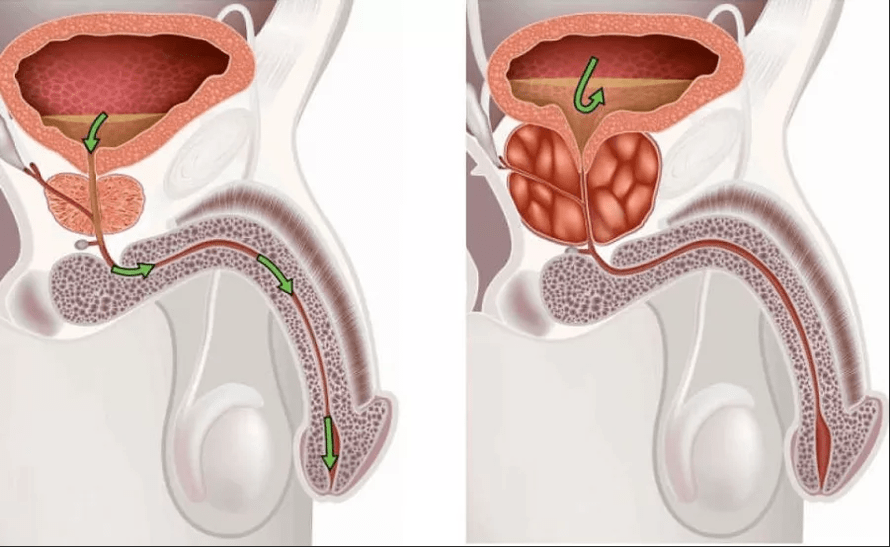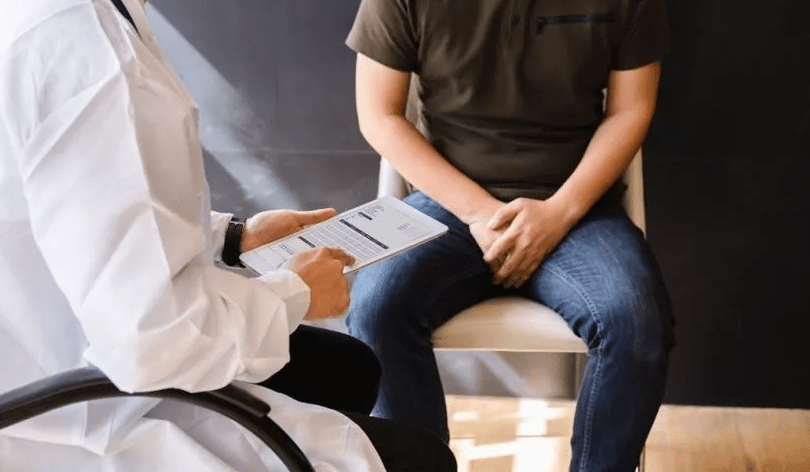The prostatitis is an inflammation of a person's prostate gland.The prostate is only under the size of the bladder and one chestnut.It covers the first part of Uretra and extends to the pelvic floor, which consists of muscles.

The prostate produces the secretion of PSA and sperm.PSA receives more fluids.Sperm is important for sperm mobility.
The prostatitis is mainly associated with severe pain in Perineum and Anal region.In addition, symptoms such as the urinary frequency, pain and pain during the urine, the symptoms occur during the inflammation of the prostate.
The prostate is relatively often affected by inflammation.The probability of prostate infection is increasing age.Studies show that in most cases between 40-50 years.
Prostatite syndrome
At the same time, the term prostatitis has revealed a broad concept of the teaching period.Several complaints with so-postatite syndrome are generally generalized in the region of the human pelvis, which is not known.The term "Prostatitis Syndrome" summarizes various clinical drawings:
- Acute bacterial prostatite
- Chronic bacterial prostatitis
- An inflammatory and input syndrome of chronic pelvic pain
- Asymptomatic prostatitis
Acute and chronic bacterial prostatitis
Acute prostatitis stems from bacteria.Pass bacteria or blood to prostate or distribute the bladder or the prostate from the bacterial infection of the urethra.The acute prostatitis is usually a serious general situation with severe pain during urine, shooting and vibrations.
Chronic prostatitis can develop sharply for more than three months, the prostate gland and microbes in the urine are repeated microbes, so much prostate, and then are chronic inflammation.
Bacterial prostatitis.This is less lightning speed than a sharp prostatitis.Although the chronic inflammation of the prostate gland is caused by pain during urine, perinium, but complaints are not usually as in a sharp prostatitis.
Chronic pelvic pain syndrome (abacterial prostatitis)
In most cases, prostate infection, bacteria cannot be unloaded as a cause of urine, prostate or disease.The trigger of the prostatitis is not known.Doctors call this chronic pelvic pain.
However, in such cases, leukocytes can often be found as an inflammatory expression in the prostate gland.To distinguish this, neither bacteria nor the disease of the disease was discovered.Chronic pelvic pain syndrome is the most common form of prostatitis.

Asymptomatic prostatitis
Rarely occur asymptomatic prostatitis.With this prostatite form, there are no signs of inflammation, there are no pain or other symptoms.Asymptomatic prostatitis is usually found as part of a study of infertility, for example, for example.
Prostatitis: Symptoms
The inflammation of the prostate can lead to various symptoms of the prostatitis.The symptoms of acute prostatitis can be very serious and a strong sense of harm, which is a chronic prostatitis, generally slightly weak.
Sharp Prostatitis: Symptoms
Acute prostatitis is often a sharp disease that patients suffer from fever and vibrations.Causes urinary burning pain and urinary flow is reduced due to the edema of the prostate gland.Since victims can only distinguish a small amount of urine, there is a constant urinary frequency and often have to go to the toilet.Other symptoms of prostatitis include bladder, pelvic pain and back pain.The pain may occur during or after ejaculation.
Chronic Prostatitis: Symptoms
The prostatitis, which is a chronic course, generally leads to less serious symptoms than the sharp inflammation of the prostate.Symptoms such as fire and cold do not contain completely.Symptoms, for example, as a feeling of pressure in the perineum or low abdomen, the darkening of the emaciation in sperm or blood blood is typical for chronic inflammation of the prostate. The symptoms of chronic bacterial and chronic abacterial prostatitis are not different.
Prostatitis complication
The most common complication is the prostate abscess.The abscess of the prostate gland is a clear inflammation of inflammation, which should be opened in general.
It can apply to nearby structures, such as further complications of the prostate, inflammation, testicles or testes.There are doubts about the development of chronic prostatitis with the development of prostate cancer.
Prostatitis: Reasons and risk factors
Bacterial Prostatitis: Causes
Only ten percent of prostatitis are caused by prostate bacteria.Bacteria can include blood or neuretria, such as blood or neighboring organs, such as an inflammatory reaction.
Escherichia coli bacteria, mainly in the human boutes, is the most common cause of the prostatitis.Klebsiella, Enterococci or Mycobacteria can also cause prostatitis.Bacterial prostatitis can also cause sexually transmitted diseases such as chlamid or trichomonas infection, as well as gonorhea.
In chronic prostatitis, bacteria in the prostate gland, prevented the human immune system yet a non-specified way.This allows germs to constantly colonize the prostate.Antibiotics are relatively weak in the tissue of the prostate gland, it can be another reason for the survival of bacteria in the prostate gland.
Chronic pelvic pain syndrome: causes
The exact causes of chronic pelvic pain syndrome have not yet been fully studied.Scientists put a lot of theory, each of them sounded accordingly, but all was not clear yet.In some cases, the genetic material of unknown microorganisms was found in the pelvis.Therefore, the cause of Pelvic pain syndrome can still be microorganisms that cannot be cultivated in the laboratory and are not discovered.
Another reason for chronic pelvis is the disorders of the bag.Due to the disabled drainage, when the volume of the bag increases, it is also pressed on the prostate.This pressure damages the texture of the prostate gland, which eventually causes inflammation.
However, in many cases, the cause of chronic pelvic pain cannot be clearly displayed.Then doctors talk about idiopathic prostatitis.
Anatomical Reasons
Rarely cause prostatite urinary tract.If the urinary trails shrinks, the urine is collected and the prostate can cause inflammation.This contraction can cause the tumor or so much prostate grinding.
Mental reasons
Recently, the prostatitis increasingly discussed psychological reasons.In particular, a mental trigger of chronic pelvic pain is likely to be a mental trigger.The exact mechanisms are still unknown.
Risk factors for the development of prostatitis
Some men are at risk, especially in the risk of developing prostate infections.These include men, for example, malfunctions of the immune system or mixed by the immune system.In addition, major diseases such as diabetes, can contribute to the development of prostatitis: the increase in blood sugar in diabetics often leads to the growing sugar in urine.The abundant sugar content in the urine can provide bacteria with good growth conditions that facilitate the development of urinary tract infections.
Another risk factor in the development of prostatitis is the bladder.The application of a catheter through urethra through urethra can damage the urethra minor rupture and prostate gland.In addition, as there is any foreign object, bacteria can be housed and so much biofilm can occur.As a result, bacteria can lead to the prostate infection for the bladder along the urethra.
Prostatitis: Exams and Diagnostics
General practice may have a medical history, but if there is a doubt of prostatitis, you will direct you to a urologist.This performs physical examination.In the case of a prostatite suspicion, it is generally a digital rectal research.However, this study does not provide clear proof of the inflammation of the prostate, but confirms doubts.Laboratory examination can be carried out to detect bacterial prostatio
Finger rectal examination
The prostate diaper is bordered by a direct rectum, which can be palpated in the rectum.These digital rectal research is usually conducted in a painless way, without an outpatient and anesthesia.The patient is asked to sleep with bent legs.Using a lubricant, the doctor then slowly enters the finger into anus and scans the prostate and adjacent bodies.Investigates the size and sensibility of the pain in the prostate gland.

Laboratory examination
In most cases, urine analysis is carried out to determine possible pathogens.The standard method is so many examples of four glasses.Here, ProstateTaxPrimat and Urin are tested by MittataExprimat and Urin after prostate massage.Doctors called prostataxprimat call prostate secretion.This is obtained by a doctor, for example, with light pressure on palpation.Ejaculation can also be tested for pathogenic microorganisms and signs of inflammation.
Additional research
The ultrasonic scan of the rectum can be used to determine where inflammation is where and how much is spread.The important goal of the study is to exclude other diseases with similar symptoms.
Except for the measurement of urine flow, resulting from the narrowing of the existing violation of the urethra drain.The influx of urine is higher than 15 to 50 millions of people in seconds, and the flow of the urine is highly probable of the urethra of the urethra.
Prostatitis: Treatment

Drug therapy
Acute bacteria prostatitis is treated with antibiotics.In light cases, the antibiotic dose is about ten days.In chronic prostatitis, medicine should be taken longer.Depending on the pathogenic microorganisms, the active items of luxury, ciprofloxacin, azithromycin, ertromycin or doxycycline are active.Even if the symptoms are already reduced, antibiotics should be continued in accordance with the appointment of the doctor anyway.
In addition, asymptomatic prostatitis are treated with antibiotics.
If there is a chronic abacterial prostatitis, antibacterial therapy is generally ineffective.Although the inflammatory syndrome of chronic pelvic pain, the lack of evidence of being pathogenic, an investigation is underway using antibiotics because sometimes it can be improved.However, antibiotic therapy is not recommended without chronic pelvic pain.
Another therapeutic approaches of chronic abacterial prostate are 5α-dated inhibitors, such as subtle or dutasteride, pentosan polyisulfat and plant medications.If improvement is not achieved, drug treatment will be completed by physiotherapy.Here, workouts are recommended for physiotherapy exercises, pelvic floor muscles or regular massage of prostate.
In addition, the symptomatic therapy can help eliminate the sharp symptoms of the prostate infection.Anesthetic drugs can be assigned to severe pain.It also helps to relax the muscles of heat bags and heat bags in the back or bottom abdomen.It often eliminates the pain with prostate inflammation.
Relapse
The frequency of the prostatitis relapse is usually very high.About 23% of victims are subject to the second episode of the disease after a disease, and 14% suffer from three or more of three or more diseases.To reduce the risk of relapse, do not wear wet clothes during prostatitis, hypothermia or bubbles such as black tea or coffee.This reduces the risk of cystitis and therefore prostatitis.However, you cannot safely prevent the bacterial prostatitis using these methods.
The prostatitis forecast, on the one hand, due to inflammation, and in the other, the sooner the correct therapy is on the other side and on the other side.
In a sharp bacterial prostatitis, which is treated as soon as possible with antibiotic therapy, the forecast is generally good.Antibiotics are usually pathogens that prevent the crossing of chronic prostate.
About 60 percent of all patients with acute prostatitis have no symptoms in six months and develops about 20 percent chronic prostatitis.Here are more difficult to treat and forecasts.In many cases, the periodic episodes of the disease have a disease that can accompany those who have been suffering for many years.
Chronic prostatitis usually requires great patience from victims.Often a long course can be a serious psychological burden.
Patients who suffer from victims should ask professional help because the prostatitis forecast of the mental health condition has a great impact.






















